
Scorpions are predatory arachnids of the order Scorpiones. They have eight legs and are easily recognized by a pair of grasping pincers and a narrow, segmented tail, often carried in a characteristic forward curve over the back and always ending with a stinger. The evolutionary history of scorpions goes back 435 million years. They mainly live in deserts but have adapted to a wide range of environmental conditions, and can be found on all continents except Antarctica. There are over 2,500 described species, with 22 extant (living) families recognized to date. Their taxonomy is being revised to account for 21st-century genomic studies.
The lesser stripetail scorpion is a small (35-55mm) species of scorpion found in Mexico and the southwestern United States.

The San Francisco Peaks are a volcanic mountain range in the San Francisco volcanic field in north central Arizona, just north of Flagstaff and a remnant of the former San Francisco Mountain. The highest summit in the range, Humphreys Peak, is the highest point in the state of Arizona at 12,633 feet (3,851 m) in elevation. The San Francisco Peaks are the remains of an eroded stratovolcano. An aquifer within the caldera supplies much of Flagstaff's water while the mountain itself is in the Coconino National Forest, a popular recreation site. The Arizona Snowbowl ski area is on the western slopes of Humphreys Peak, and has been the subject of major controversy involving several tribes and environmental groups.
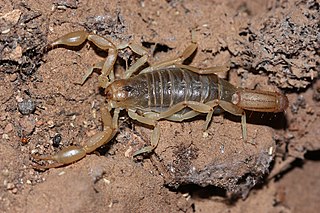
Paravaejovis spinigerus, commonly known as the stripe-tailed scorpion or devil scorpion, is a species of scorpion in the family Vaejovidae. It is found in the south-western United States and north-western Mexico.

The Buthidae are the largest family of scorpions, containing about 100 genera and 1339 species as of 2022. A few very large genera are known, but a high number of species-poor or monotypic ones also exist. New taxa are being described at a rate of several new species per year. They have a cosmopolitan distribution throughout tropical and subtropical environments worldwide. Together with four other families, the Buthidae make up the superfamily Buthoidea. The family was established by Carl Ludwig Koch in 1837.

Centruroides is a genus of scorpions of the family Buthidae. Several North American species are known by the common vernacular name bark scorpion. Numerous species are extensively found throughout the southern United States, Mexico, Central America, the Antilles and northern South America. Some are known for their interesting patterning or large size ; most if not all fluoresce strongly under ultraviolet illumination, except after moulting. They contain several highly venomous species, and fatalities are known to occur. The venom of the Mexican scorpion Centruroides limpidus limpidus contains the neurotoxins Cll1 and Cll2.

Euscorpius is a genus of scorpions, commonly called small wood-scorpions. It presently contains 65 species and is the type genus of the family Euscorpiidae – long included in the Chactidae – and the subfamily Euscorpiinae.
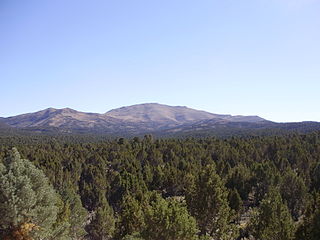
Pinyon–juniper woodland, also spelled piñon–juniper woodland, is a biome found mid-elevations in arid regions of the Western United States, characterized by being an open forest dominated by low, bushy, evergreen junipers, pinyon pines, and their associates. At lower elevations, junipers often predominate and trees are spaced widely, bordering on and mingling with grassland or shrubland, but as elevation increases, pinyon pines become common and trees grow closer, forming denser canopies. Historically, pinyon-juniper woodland provided a vital source of fuel and food for indigenous peoples of the American Southwest. The nuts continue to be a traditional indigenous food, and because nut-collecting was also adopted by the Spanish in the 1500s, the nuts are also traditionally harvested by some Hispanic communities.

Vaejovidae is a family of scorpions, currently comprising 25 genera and over 230 species, found in North America. The species of the family are found from western Guatemala, throughout Mexico, and in the United States, mostly west of the 100° meridian and one species in the Appalachian Mountains. Small, montane species of the genus Vaejovis have been found in pine and spruce forests at elevations over 9,500 feet in New Mexico and Arizona. The northern scorpion, Paruroctonus boreus, is found from northern Arizona to the southern plains of Saskatchewan, Alberta, and British Columbia in Canada and is the northernmost known species of scorpion in the world.

Paruroctonus boreus, commonly known as the northern scorpion, is a species of scorpion in the family Vaejovidae. It is the northernmost species of scorpion, the only scorpion found in Canada, and one of the scorpions with the broadest distribution over North America.
Vaejovis brysoni is a species of scorpions belonging to the family Vaejovidae discovered in 2013 in the Santa Catalina Mountains of southern Arizona. It was reportedly discovered in an area that overlooks the city of Tucson by Robert W. Bryson Jr., after whom the species is named. At the date of its discovery it became the tenth species of mountain scorpion known to occur in Arizona, and the second in the vorhiesi group to inhabit the specific mountain range.

Superstitionia donensis is a species of scorpion, the only species in the genus Superstitionia and the family Superstitioniidae.
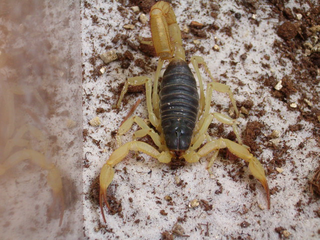
Hadrurus is a genus of scorpions which belongs to the family Hadruridae. They are found in sandy deserts and other xeric habitats in northwestern Mexico and in southwest United States. They are among the largest of all scorpion genera, only surpassed by Hadogenes, Pandinus, Heterometrus and Hoffmannihadrurus.

Smeringurus is a small genus of scorpions native to Mexico and the southwestern United States within the family Vaejovidae. It is closely related to the genus Paruroctonus, of which it was formerly considered a subgenus.
The taxonomy of scorpions deals with the classification of this predatory arthropod into 13 extant families and about 1,400 described species and subspecies. In addition, 111 described taxa of extinct scorpions are known.

Paruroctonus is a genus of scorpions in the family Vaejovidae. There are about 10 described species in Paruroctonus.
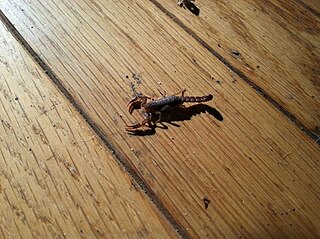
Vaejovis carolinianus, the southern unstriped scorpion, also known as the southern devil scorpion, is a species of scorpion in the family Vaejovidae.
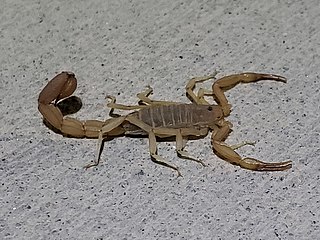
Paravaejovis is a genus of scorpions in the family Vaejovidae. There are about 11 described species in the genus Paravaejovis.
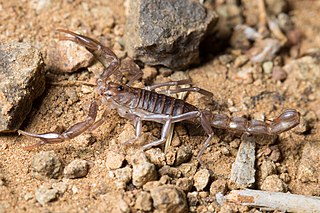
Serradigitus is a genus of sawfinger scorpions in the family Vaejovidae. There are more than 20 described species in Serradigitus.
















